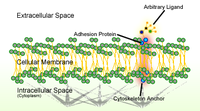
Photo from wikipedia
Migrating neutrophils are found to leave behind subcellular trails in vivo, but the underlying mechanisms remain unclear. Here, an in vitro cell migration test plus an in vivo observation was… Click to show full abstract
Migrating neutrophils are found to leave behind subcellular trails in vivo, but the underlying mechanisms remain unclear. Here, an in vitro cell migration test plus an in vivo observation was applied to monitor neutrophil migration on intercellular cell adhesion molecule-1 (ICAM-1) presenting surfaces. Results indicated that migrating neutrophils left behind long-lasting, chemokine-containing trails. Trail formation tended to alleviate excessive cell adhesion enhanced by the trans-binding antibody and maintain efficient cell migration, which was associated with differential instantaneous edge velocity between the cell front and rear. CD11a and CD11b worked differently in inducing trail formation with polarized distributions on the cell body and uropod. Trail release at the cell rear was attributed to membrane ripping, in which β2-integrin was disrupted from the cell membrane through myosin-mediated rear contraction and integrin-cytoskeleton dissociation, potentiating a specialized strategy of integrin loss and cell deadhesion to maintain efficient migration. Moreover, neutrophil trails left on the substrate served as immune forerunners to recruit dendritic cells. These results provided an insight in elucidating the mechanisms of neutrophil trail formation and deciphering the roles of trail formation in efficient neutrophil migration.
Journal Title: ACS applied materials & interfaces
Year Published: 2023
Link to full text (if available)
Share on Social Media: Sign Up to like & get
recommendations!